Last week at the Political Equator 3 conference, which described itself as a “2-day cross-border event” occurring simultaneously in Tijuana and San Diego, something very interesting happened on an inner edge of North American nation-state geography.
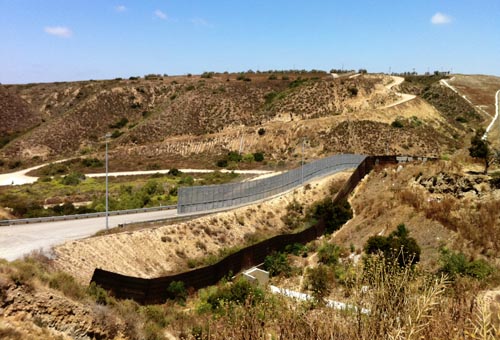 [Image: The U.S./Mexico border photographed by Quilian Riano].
[Image: The U.S./Mexico border photographed by Quilian Riano].
For one afternoon only, Mexico formally welcomed international border-crossers, coming south from the United States, into the country at a temporary checkpoint located at the mouth of an underground drain.
“This is the first time ever that Mexico designates a drain as an official port of entry,” Oscar Romo, one of the conference co-organizers, explained to the Washington Post, “and it’s probably not going to happen again.”
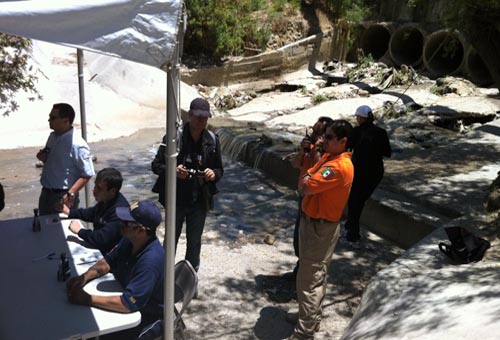
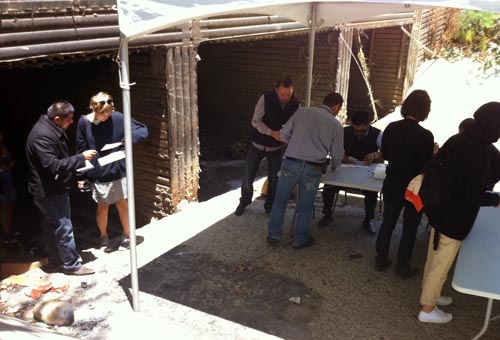
 [Images: A temporarily official Mexican entry point, photographed by Quilian Riano].
[Images: A temporarily official Mexican entry point, photographed by Quilian Riano].
“Travelers clutching passports snapped photos as they walked along the muddy culvert,” the Washington Post continues. “One man switched on a head-mounted light as the group entered a dark 40-yard stretch that took them underground. Mexican officials at folding tables issued visas at the south end of the drain.”
For this brief phase in international relations, then, the U.S./Mexico border formally included a strange, pop-up entry/exit point. A kind of embassy of the porous. Passport stamps from the experience must surely stand as some of the most unique in the world, like some variation on philatelic collecting. In fact, I’m led to wonder if a history of unusual, but officially recognized, border-crossings has ever been written, populated with examples from espionage, political asylum, wartime defection, extraterritorial immigration, enclaves/exclaves, civil dissolution, divided cities, and much more. There should be a narrative tour of this officially-stamped peripheral geography where lines are crossed—a ghostly international world of ambiguous nation-state terrains where sovereignty is both temporary and unclear, though the rituals of the state remain.

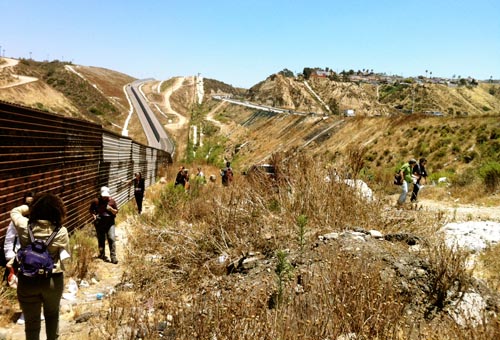 [Images: The U.S./Mexico border photographed by Quilian Riano].
[Images: The U.S./Mexico border photographed by Quilian Riano].
Architect and designer Quilian Riano was on hand for the crossing, and these are his photographs reproduced here. By way of email, Riano described the physical terrain where they crossed beneath and through the border, remarking that the hydrological status of the land there “really makes you think about how arbitrary borders are.”
On one side of the border there is an emphasis on surveillance while, on the other side, a series of systematic social, economic, and environmental policy failures have created a hazardous living condition for thousands of Tijuana’s poorest. The failure, however, can be felt on both sides, as the watershed pushes the sediment and trash from the illegal settlements in Tijuana’s Los Laureles Canyon directly across the border into the Tijuana River Estuary State Park. While politicians on both sides demagogue, the lack of communication and collaboration between the two nations leads to social and environmental catastrophe.
The border crossing itself thus aimed “to follow the path of the water, trying to understand the border through its ecological and social impacts,” and opening, in the process, a negotiated pore in the outer edge of sovereign geography through which human beings, like imperial sweat, could flow.

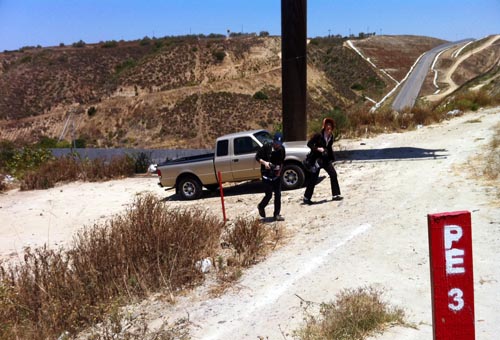
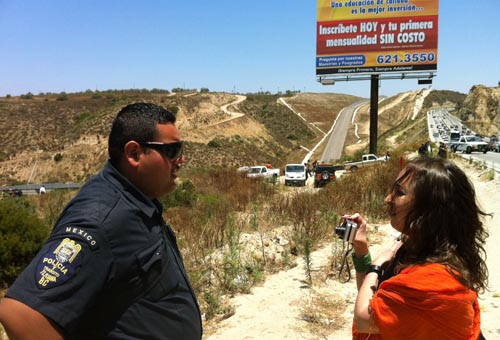 [Images: Photos by Quilian Riano].
[Images: Photos by Quilian Riano].
This particular border-crossing is, of course, now (officially) closed, and we shouldn’t overlook the still very heavy police presence that this media-friendly moment entailed—as well as the fact that it only moved north to south. This temporary welcome mat faced one way.
Nonetheless, it is hard not to feel excited that the topology of the nation-state might yet continue to reveal these rough edges not as points of deflection but as ports of entry—that openly carnivalesque gates and fringe geographies through which adjacencies are encouraged, not denied, might spatially instigate a true age of neighbors.
 [Images: Pointing past the nation-state; photo by Quilian Riano].
[Images: Pointing past the nation-state; photo by Quilian Riano].
As the Political Equator 3 conference more practically suggests, the “peripheral communities and neighborhoods where new economies are emerging and new social, cultural and environmental configurations are taking place” could thus accelerate their vital role as “catalysts” for an overall calming of geography: a future recession in the tide of hardened borders that uncovers more and more such sites of interpenetration.

I'm reminded of one of my favorite novels, Blood Meridian, in which the lack of any true separation along the border creates this hybrid, ambiguous landscape where the protagonists wander an almost hellish world of constant in-between.
I think this bleeding of boundaries still exists in the south. Growing up in Texas, I was always struck by the long expanses of "nothing" that both seemed to connect and separate the smaller towns interrupting the expanse. I know it's not the same as what's mentioned here (though I certainly think a case can be made that one has influenced the other), but I've always found the cultural, physical, and political aversion to boundaries–despite our own tendency to erect them and architecture's predication on them–fascinating.
I'm led to wonder if a history of unusual, but officially recognized, border-crossings has ever been written, populated with examples from espionage, political asylum, wartime defection, extraterritorial immigration, enclaves/exclaves, civil dissolution, divided cities, and much more.
That's very interesting. It reminds me of my husband's grandfather, who was one of the German rocket scientists captured by the Americans during WWII, and they were brought to America with the status, 'enemy alien,' unable to leave the country. Eventually, the entire family had to make a trip to Niagara Falls and 'officially' enter the country… It was all documented in his papers, which we had at one point after he died, but donated to a museum.
If the "history of unusual, but officially recognized, border-crossings" is ever written, then I would like to submit my personal favorite: the Detroit Marathon. This annual footrace crosses the Detroit River via the Ambassador Bridge into the Canadian city of Windsor before returning to the USA under the river by way of the Windsor Tunnel.
I participated in this marathon in 2006 and, although temporary, it is actually the rituals of the state that were altered for the event. Instead of carrying passports, the runners' bib serves as their temporary official passport. If the numbers are obscured, a runner risks what I imagine would be a very unpleasant encounter with the border patrol (who were numerous, with dogs and visibly well-armed).
FreedomPlease.Org ; I made the first day, but didn't get to cross the border, 8^(. Already had plans and haven't gotten a passport recently. I was so saddened to see Mexico "close" the border as we had done so many years ago. None of it is good. It makes everything cost more & in hard economic times hurts all those but profiteers. The area is so unique. And I miss going to Mexico.
I hope much was learned! I learned and enjoyed San Ysidro so much! Thank you Ralph (Inzunza), and all the tour leaders, Teddy, conference speakers, Professors/teacher/students, Politicos, activists and general citizens. It was a genuine pleasure to meet so many of you. I have more pics, and videos (coming soon) at Walkwithhim (facebook). If you ever make it to the San Diego region look up one or more of my groups to hike and see the area: Walkwithhim & WalksWithGod (facebook) &/or http://www.meetup.com/San-Diego-Outdoor-Enthusiasts/ daniel , daniel_beeman@yahoo.com 858-571-6058